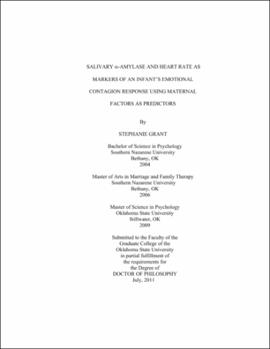| dc.contributor.advisor | Thomas, David | |
| dc.contributor.author | Grant, Stephanie | |
| dc.date.accessioned | 2013-11-26T08:27:39Z | |
| dc.date.available | 2013-11-26T08:27:39Z | |
| dc.date.issued | 2011-07 | |
| dc.identifier.uri | https://hdl.handle.net/11244/6945 | |
| dc.description.abstract | Scope and Method of Study: | |
| dc.description.abstract | Empathy generates interest due to its implications for prosocial development. Work in this area examining infant populations is limited, specifically between 3 and 9 months of age, however, in part due to difficulties in measurement. While mature empathy is not developed until a later age, a rudimentary version of empathy referred to as emotional contagion (EC) does appear to be present. One purpose of the present study was to examine whether a recent form of measurement of the sympathetic nervous system (SNS) called salivary a-amylase (sAA) could be used in addition to heart rate (HR) as a method of assessing EC in 3 and 6 month old infants. Furthermore, evidence reviewed suggests that maternal responsiveness appears to mold empathy development. Infants and their mothers (N = 36) visited the laboratory when the infants were 3 and 6 months of age. Mothers were assessed through self-report measures on parenting risk, parenting stress, and parenting styles at the 3-month visit only. At both visits infants were played a 5 min recording of another infant crying. During this time, HR data was collected and sAA (6 month visit only) from infant saliva was collected before and after the cries played. | |
| dc.description.abstract | Findings and Conclusions: | |
| dc.description.abstract | Results showed that both HR (non sig.) and sAA levels (sig.) increased in response to the cries. Such results lend support to the use of sAA as a measurement of EC in infants at the age of 6 months and suggest that the developmental emotional contagion response appears to be an increase in SNS arousal. Relations between HR and sAA, while present, were not uniform. HR difference at 6 months was positively correlated to post cry sAA levels and greater differences in sAA. Few relations were found between HR at 3 months and maternal factors and no significant correlations were seen with maternal factors and sAA or HR at 6 months. Greater changes in HR were associated with lower levels of maternal stress and level of permissiveness was negatively related to baseline HR. Data presented might suggest a developmental difference between infant ages concerning their SNS or an inconsistency in the developmental trajectory of emotional contagion. Limitations and suggestions for future research were also discussed. | |
| dc.format | application/pdf | |
| dc.language | en_US | |
| dc.rights | Copyright is held by the author who has granted the Oklahoma State University Library the non-exclusive right to share this material in its institutional repository. Contact Digital Library Services at lib-dls@okstate.edu or 405-744-9161 for the permission policy on the use, reproduction or distribution of this material. | |
| dc.title | Salivary a-amylase and heart rate as markers of an infant's emotional contagion response using maternal factors as predictors | |
| dc.contributor.committeeMember | Hubbs-Tait, Laura | |
| dc.contributor.committeeMember | Byrd-Craven, Jennifer | |
| dc.contributor.committeeMember | Beasley, Lana | |
| osu.filename | Grant_okstate_0664D_11555.pdf | |
| osu.accesstype | Open Access | |
| dc.type.genre | Dissertation | |
| dc.type.material | Text | |
| dc.subject.keywords | a-amylase | |
| dc.subject.keywords | emotional contagion | |
| dc.subject.keywords | empathy | |
| dc.subject.keywords | heart rate | |
| dc.subject.keywords | parenting | |
| dc.subject.keywords | stress response system | |
| thesis.degree.discipline | Lifespan Developmental Psychology | |
| thesis.degree.grantor | Oklahoma State University | |
